@barnee Thanks so much Play Well!!
World War II in Europe now at HBG
-
Summer 1940.
Italy invades Greece to get some more valued territory. Athens is attacked from Albania and amphibiously. Germany moves its units around to get ready for Russia. They also attack the British beachhead in Brussels while it is weak. Germans also finish off Yugoslavia by attacking Belgrade.
Now that the channel isn’t blocked, the German u-boats come out. 1 sub to each convoy the British have.
To attack a convoy, a sub merely needs to enter a space that the convoy travels through as indicated by the zigzag lines (I used Battle of the Bulge markers for this, but making your own straight markers would be better.) If there are more than 1 convoy in the sea space that the sub is attacking, then the sub needs to choose which convoy it will attack.
Planes and ships can try to intercept the German ships, but the British have no ASW ships or planes in port to do this, the cruisers, battleships and empty carrier stay in port as they are not equipped to attack subs. Britain needs destroyers badly (some are being built now in the construction boxes but are some turns away still).
Submarine warfare is only 1 round. Attacker rolls for each sub he has attacking a convoy. 3 or less and the defender loses a transport for each hit. Defender rolls for each destroyer or other ASW unit he has. 3 or less is a hit and each hit removes a sub. Attack is over.
-
The Germans manages to destroy the convoys to Egypt (around the horn of Africa), Brussels and Canada, while the convoy to South Africa defended and killed the attacking sub, and the Caribbean convoy was unharmed.
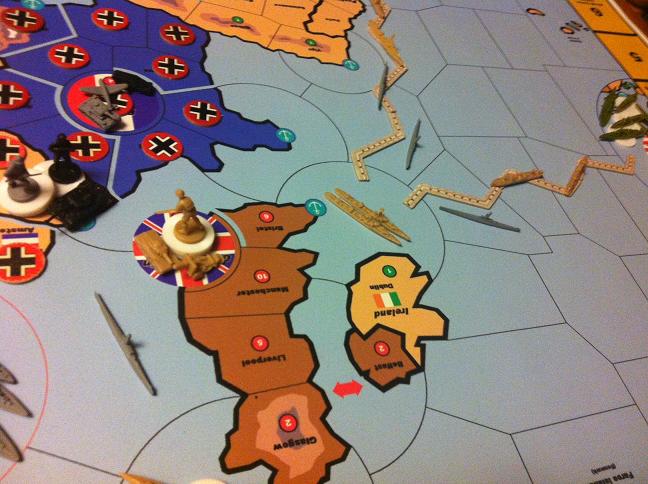
-
The Italians failed in taking Athens ( :roll:). Even thought he Greeks are affected by ‘surprise attack’, they still get defence bonuses. The Greek infantry are defending in mountainous terrain, so they get +1 to their defence. If it weren’t for the Italian infantry coming in from Albania, the Greeks would also get a +1 defence for defending a coastline. The Italian battleship bombards the shore with the Greek artillery returning fire (Much like Axis & Allies: WWI 1914 - although I came up with this long ago!). Casualties are removed and combat then resumes normally. Italy lost.
The Germans took Belgrade and destroyed the beachhead in Belgium.
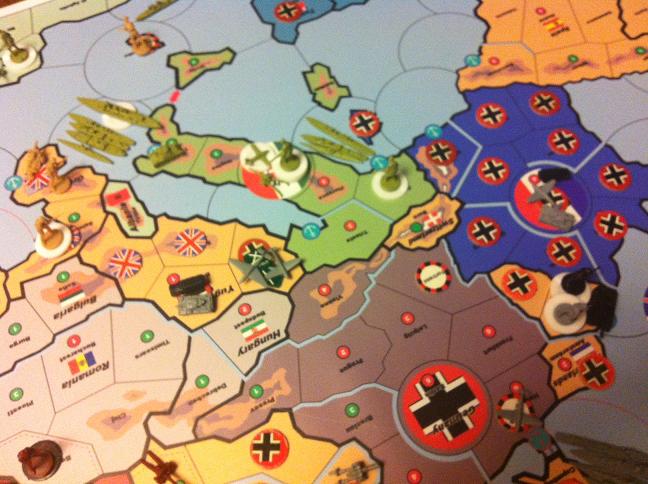
-
The Greeks move all units to defend Athens, while the Germans rail units in to Albania to finish the job the Italians started.
Itlay starts a convoy to Tripoli to supply the Italian army outside of Libya.
German subs station in Brest to be closer to the British convoys.
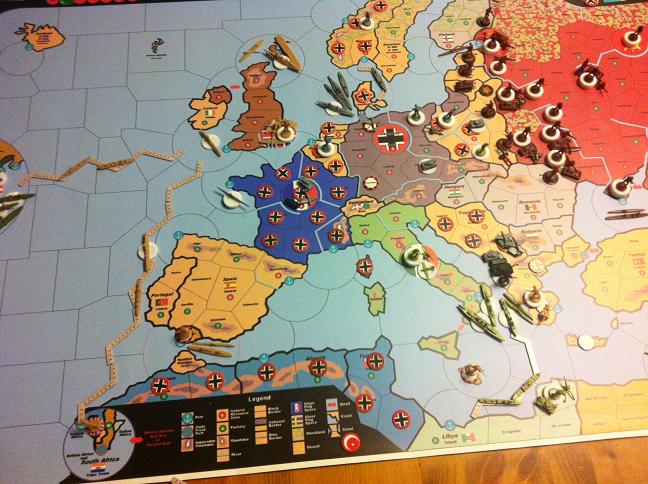
-
Units are placed - those in the build boxes are moved up 1 box.
Germany collects $90
Italy collects $20
UK collects $49It is now fall 1940
-
Fall 1940,
Germany moves into Athens. Italy moves into Egypt.
The German subs attack the remaining UK convoys, while teh Italians move their fleet into position to block the UK fleet at Alexandria.
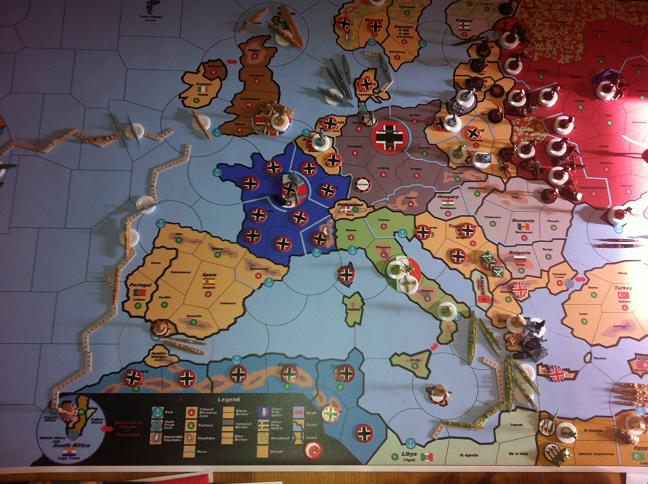
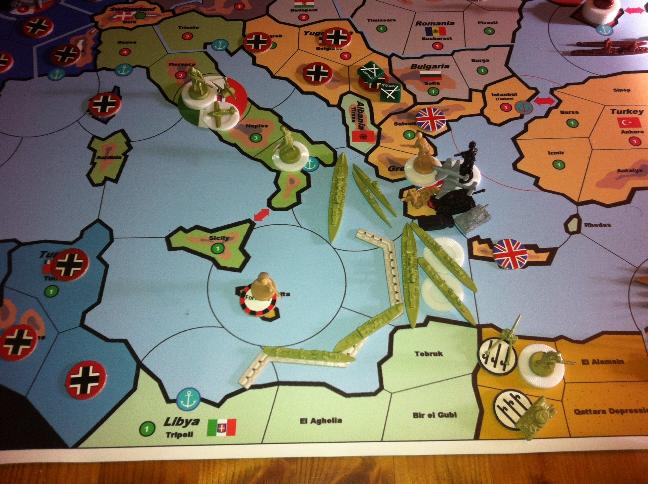
-
Now the Allies move.
UK is alone. They will try to intercept the u-boats using the 2 destroyers and Tac form Bristol.
Interception is rolled on 1d6 for each group of units intercepting those subs (path traced in blue). The UK will try to intercept them in the space right next to the Bristol port.
Interception is harder to do the farther away from your port you are. At 5 or more spaces away from your port (or airbase), you need to roll a 1 to be successful. 4 spaces is 2, 3 spaces is 3 and so on. The Brits are trying to find these subs 1 space away from the destroyers, so they need a 5 or less to find them. The Tac is 2 spaces away, so they need a 4 or less.
Only ASW units can attack subs. But to make matters worse, subs are hard to find so interception rolls against subs will have a penalty.
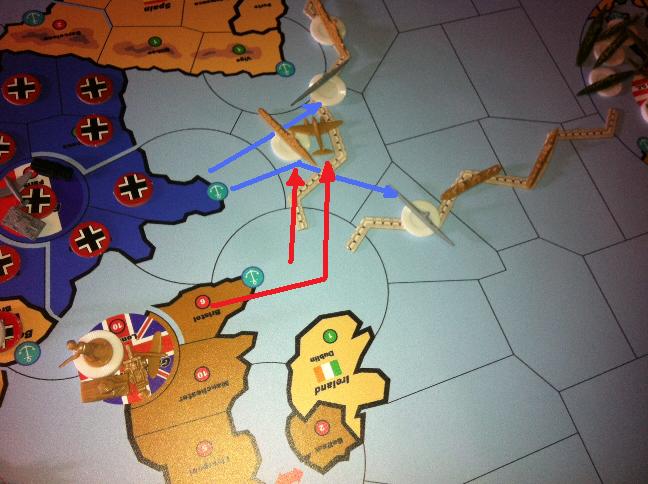
-
The UK will also try to hit the Italian convoy using the sub from Gibraltar.
The UK fleet from Alexandria will try to engage the Italian fleet.
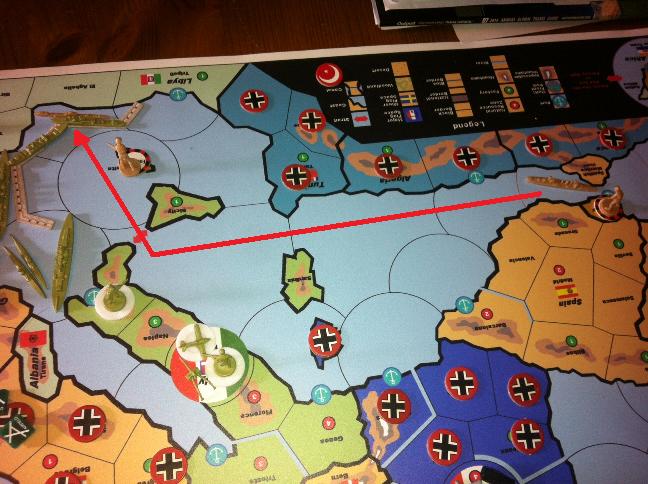
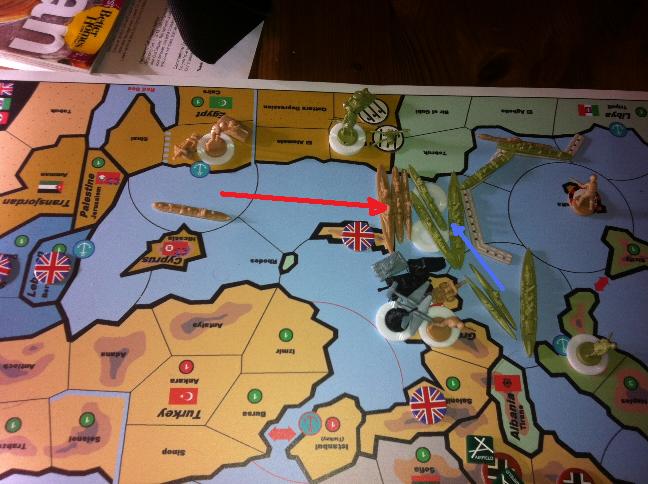
-
This looks really promising. An advanced type of A&A game with much more historically accurate rules and a map featuring terrain!
How does this map compare in size to the barbarossa and Global '39 maps?; both of which i own.
I suspect HBG offers it printed on vinyl, just like the above games?
Just how finalized is the game? To be quite honest, I’m a bit sick and tired of the regular A&A games by wizards being constantly horribly unbalanced and in need of major revisions upon release.
Thanks.
-
Sorry, busy with work as of late. I’'l continue this game when things settle down.
There are 2 start dates - fall 1939 and spring 1941. I have been wanting to get a set-up for spring 1943 but haven’t had time.
There are now 2 sets of rules. Basic is very much like A&A while advanced is quite a bit different. The game I am outlining here is using the advanced rules. Basic was introduced because there were those who didn’t care for the deviation from the A&A mechanics and the complexity was a bit much for them.
Map size is 70 cm by 110 cm. It is printed on vinyl.
My group has found that it is pretty balanced - especially the 1941 scenario. So far there have been no 'buy this and do this and you win the game.
Mind you, we have played it enough that we have refined our tactics. New players will take some time to figure out the nuances of the game.
-
Sorry, busy with work as of late. I’'l continue this game when things settle down.
There are 2 start dates - fall 1939 and spring 1941. I have been wanting to get a set-up for spring 1943 but haven’t had time.
There are now 2 sets of rules. Basic is very much like A&A while advanced is quite a bit different. The game I am outlining here is using the advanced rules. Basic was introduced because there were those who didn’t care for the deviation from the A&A mechanics and the complexity was a bit much for them.
Map size is 70 cm by 110 cm. It is printed on vinyl.
My group has found that it is pretty balanced - especially the 1941 scenario. So far there have been no 'buy this and do this and you win the game.
Mind you, we have played it enough that we have refined our tactics. New players will take some time to figure out the nuances of the game.
Thanks. A bit of complexity is no problem. Like I said, I really like the added terrain. If there are some rules about the advanced version I should really dislike (which i don’t expect) I could always leave them out, I suppose or simplify them. OK, I’ll wait for HBG’s European distributor to have it available. Considerably cheaper shipping and no import duties.
-
Hi Jim010,
I’ve just bought this awesome looking map as I’ve always wanted a deeper variant of A&A with terrain rules etc.
I haven’t played it yet, but I have some questions:
Looking at the cost and attack values of tanks, it seems to me they are of relatively little value, because:
- They are much more expensive than (mechanized) infantry, while the latter get defensive bonuses in terrain and behind a river, while a tank does not.
- While tanks can take part in Blitzkrieg attacks (I really like the surprise attack, as without it such an attack would certainly be suicidal, i.e. exchanging expensive tanks and mechanized infantry against regular infantry in many cases…), they still seem very vulnerable to counter-attack when the same exchange would likely occur. Or can you redeploy friendly infantry to bolster your defenses in just captured territories. Would make sense actually as a turn is an entire season…
- Do tanks get attack bonuses when paired up with tac bombers? (Sorry, but I have so many A&A games and variants thereof that it’s hard to keep track of which game does and which one doesn’t. i noticed that it wasn’t explicitly described in the rules).
Another question/ remark:
- Have you considered using weather effects per front in the advanced/ expert rules?
Example: Eastern front autumn: Roll a die: On a 1-2 apply Summer eastern front conditions; on a 3-4 apply Autumn conditions; on a 5-6 apply winter conditions
Summer: No effect (Use standard game rules)
Autumn: Due to muddy conditions, maximum movement is one (except for redeployment, which is unaffected); no blitzkrieg allowed.
Winter: All Axis units attack at -1 (to a minimum of “1”)And for Eastern front Spring:
On a 1-2 No effect (i.e. same a Summer conditions)
On a 3-4 Use autumn/ mud conditions
On a 5-6 use winter conditions.Great looking map. My compliments. Looking forward to giving it a try!
-
Unless already at war, any country - whether it is a player nation or minor country - will be affected by ‘surprise attack’ rules. ‘Surprise attack’ rules state that a country so affected cannot move any units in movement phase, and all units defend at 1. Bonuses for terrain still apply and units in a fortress or supply depot defend normally.
Normally, the Allies would counter-move after the Axis are finished doing their moves, but France, UK and Poland (the only active Allies at the start) are considered to be first time attacked by Germany and therefore suffer ‘surprise attack’. (I know that France and UK declared war on Germany, not the other way around, but their inaction in the first few months is replicated by this rule)
While neutral, USSR cannot conduct a turn except to occupy its half of Poland and associated territories. It must have enough units to occupy these zones and prevent a Nazi take over of any of these zones.
All attacks are successful. The attack on Krakow is successful and opens up the way to Warsaw.
Germany then uses all blitzkrieg capable units that have not already been used to move into Warsaw. Even if a tank was attacked in Movement phase, as long as it didn’t MOVE, then it can still be used in Blitzkrieg phase.
Only the side that has initiative can conduct Blitzkrieg (in this case it is the Axis). Units defending against blitzkrieg also suffer ‘surprise attack’ as stated above.
Can neutral forces be used to represent the Poles (HBG pieces)or is it somehow essential British troops are used?
Also, I assume the dark German pieces are SS units? I don’t see these on the set-up charts :?
-
Sorry I haven’t been frequenting these boards. My career has been keeping me busy, plus I have moved into a new home and am now busy doing home renovations.
Right now I am at work, so I’ll answer questions later today.
Cheers
-
Can neutral forces be used to represent the Poles (HBG pieces)or is it somehow essential British troops are used?
Also, I assume the dark German pieces are SS units? I don’t see these on the set-up charts huh
You can certainly use a different colour to represent the Poles, but the UK will still control them. Neutrals that align with the Allies are controlled by the UK, which is why UK pieces are used to represent the Poles, while those that join the Axis are controlled by the Germans.
As for the SS pieces, that is optional, so those units are not found in the set-up charts, but are dealt with in the options section of the rules.
Cheers
-
Can neutral forces be used to represent the Poles (HBG pieces)or is it somehow essential British troops are used?
Also, I assume the dark German pieces are SS units? I don’t see these on the set-up charts huh
As for the SS pieces, that is optional, so those units are not found in the set-up charts, but are dealt with in the options section of the rules.
Cheers
I saw that, but as they were already used in the attack against Poland I figured there had to be an alternate set-up chart listing them. How can they already be on the board on turn 1?
-
WW2 in Europe/ Europe at war Questions and suggestions
So after having read the rule book and getting a feel for the game and its mechanics, I’m now ready to play a more serious (solo) game. However, I do still have a fairly large number of questions:
1.) Does attacking artillery also fire in the shore bombardment step? The rules suggest that it does as it states: “artillery that fired in step 2 cannot fire now” or something along those lines (land combat sequence).
Mt 2cts: I suggest renaming “shore bombardment” into “opening fire” when it comes to land combat. I’d also go for giving both sides a choice: Either fire your artillery in the opening fire step and any casualties caused are removed immediately (firing side’s choice on a roll of “1”) or attack/ defend during each round of normal combat along with other units. In this case any casualties caused are always the owning player’s choice.
2.) I still don’t really get that under some units it is stated that on die rolls of “2” they can choose which unit is hit, but then strangely enough it goes on to say that this is always the owning player’s choice. What exactly does the firing player get to choose then?!
My 2 cts: allow the firing player to choose the target rather than the owning player (and on a 3 or 4 in case of a tactical bomber, for instance, the owning player decides.
3.) Can the Russians attack the lone Polish infantry on their side of the demarcation line in Fall ‘39? The rules say they may move into the areas designated to them, but it doesn’t say anything about attacking.
My 2 cts: Allow it! This is also what happened historically!
4.) Illustration Page 9 advanced rules: Assuming Belgium is being attacked here for the first time and is therefore suffering from the penalties related to “surprise attack”, how can they possibly reinforce Liege from Brussels as the rules state that units suffering from surprise attack may not move, neither in the movement phase nor in the blitzkrieg phase. Or is this done by “British” units (as the Belgians are now represented by British units after having been attacked) using British redeployment points? From the example I certainly don’t get that impression…I assume this is a faulty illustration??
5.) Does the UK collect money from the neutral territories whose forces it represents? I guess not, but just wanted to make sure…
6.) Do neutrals get to build any forces if they are not defeated at the end of a turn?
My 2 cts: I’d allow them to build units up to the value of the territories they still control, as long as they are still in possession of their capital (to be placed in box 1)
7.) Can ships belonging to belligerent nations pass through ports [with ships in them] belonging to neutral powers? (I.e. French and British ships, for example, while not yet at war with Italy could pass through the sea zone containing the port of Tripoli or French ships could trace a convoy through the sea zone containing the port of Barcelona).My 2 cts: I’d leave it to the nations controlling the port; they can either allow it or deny it. A denial would not be a declaration of war!
8.) Please emphasize in the rules that if the Axis attacks either the USA or the USSR prior to Spring 1942 both can only receive up to 25% of their income. This is a bit vague.
9.) Why do fighters have such a low combat value when it comes to attacking ground units? (and why such a high one while attacking other air units)?
10.) If I understand it correctly the “4” combat value of fighters is only used in air to air combat? (I.e. escorts vs interceptors and when air units ONLY meet in a certain territory? (for instance in order to pin enemy air units there?)
11.) Was an air-to-air combat phase deliberately left out of the land combat sequence? It would make sense to me if attacking and defending aircraft would first engage one another and that any surviving fighters and tactical bombers (from both sides) would then get to make a(n) (pre-emptive) attack against an enemy ground unit of their choice.
12.) Do naval units exercise sea control while still neutral? (i.e. would Italian naval units and tac bombers -that are still neutral in 1939- inflict movement penalties on e.g. a British convoy?
My 2 cts: No. Not until they are at war with one another do such penalties apply
13.) While a (major) nation is neutral, does it receive supply automatically or does a convoy still need to be established to receive supplies from overseas?
14.) Is it possible for naval units of befriended nations to ever share a port together at the end of a turn? (E.g. British ships in a French port; when dropping off transported units the rules state a transport must return to its port of origin, so e.g. a British transport transporting a unit to Brest would have to return to Bristol rather than remaining in Brest, right?)
15.) The text underneath “Minor flag space” differs significantly between the basic and advanced rules. Is this intentional? For example, in the basic rules it says that units located in a minor flag space only suffer the movement penalty in case of a surprise attack, but this is not listed in the advanced rules.
16.) Why does Italy receive money from the start for Tripoli while the UK doesn’t for its African territories? Because the UK is at war and Italy is still neutral?
17.) Are British and French naval units also bound by the rules governing surprise attack in Fall ’39? If so, this seems like the time for the Germans to attack e.g. Scapa flow!! If so, would the port bonus apply regardless?
18.) It took me a long time before I got the air redeployment example. Air units can only land/refuel/rebase on “factory spaces”, right? And not on NRZ’s? I take it they can also refuel on carriers?
19.) Can air units with a movement value ever fly from the US to Britain or is the only way to do this by means of transporting them by ship? (refueling on Iceland still doesn’t give them enough movement points).
20.) The US starts with $20, however its income is $50 (1/4 of 200). Is this correct? Or do they get to spend $20 on their first turn and afterwards $50? If I’m not mistaken neutral countries do not get to actually buy and place units until activated?(But they do get them to advance up the build boxes?)
21.) How is a convoy set up to the Pacific holding box? (simply to the “picture”?)
22.) What happens when a convoy needs to spend more than 10 mp’s? Does this then count against [naval] rp’s? Do rp’s then need to be saved from the redeployment phase?






